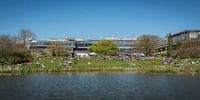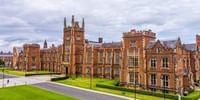It builds upon the School's extensive research in human osteology and palaeopathology and related research expertise in field archaeology, archaeozoology, molecular archaeology and archaeological biogeochemistry.
The Human Osteology and Palaeopathology course from University of Bradford strongly emphasises the integration of biological and archaeological evidence to address problem-orientated research themes and the application of scientific methods to unravelling the human past.
It provides advanced instruction in the identification and analysis of human remains, the techniques and methods applied to understanding human skeletal morphological variation, and the means by which to assess pathological conditions affecting the skeleton.
The course can be used either as vocational training or, for the MSc, as a foundation from which to commence further research. The course is normally offered on a full-time basis but a part-time route is feasible as well. Individual modules are available to candidates wishing to enhance their specialist knowledge in a particular area.
Special Features
- The course provides access to our world renowned collection of reference material (The Bradford Human Remains Collection), hands-on experience in laboratories, and a substantial individual research dissertation
- Studentships from the Arts and Humanities Research Council (AHRC) are available on this course
- A part-time route is feasible, accumulating module credits over a period of study. Individual modules are available to candidates wishing to enhance their specialist knowledge in a particular area
- First destination figures indicate that about 85% of postgraduates in Archaeological Sciences achieve work or further studies in the discipline or cognate areas
Facilities
The MSc Human Osteology and Palaepathology extensively utilises the Bradford Human Skeletal Collection of over 4000 skeletons dating from the Neolithic to the 19th century.
This allows us to teach using a wide range of skeletons to demonstrate the range of variation seen both between individuals but also between pathological alterations resulting from the same disease process. The collections (many on long-term loan from various museums) include 35 individuals from a mass grave relating to the Battle of Towton (AD 1461); a medieval leprosarium and alms house in Chichester; Wetwang Slack, the largest Iron Age cemetery excavated in England and Wolverhampton, a 19th-century cemetery from an industrial city.
We have three dedicated osteology labs - for teaching, research and masters study. Our histology lab contains thin sectioning saws and slide preparation facilities. The dedicated microscopy lab contains both reflected and transmitted light microscopes, and a low powered dissection microscope. We often take x-rays of human remains using our radiography suite and we have an extensive collection of over 5000 clinical and skeletal radiographs.
Our FARO 3D laser scanner is currently being used to scan bones for the Digitised Diseases project, but has been used by students for dissertation research.
Finally our isotope laboratories offer the opportunity to prepare samples and analyse them for a range of stable light isotopes.
Students are encouraged to study in the labs using the skeletal material outside of dedicated teaching hours.
Career Prospects
Career destinations after the MSc Human Osteology and Palaeopathology have included:
- Lecturers, teaching assistants and post-doctoral researchers at UK universities
- Osteologists and archaeologists working in commercial archaeology
- Education and curatorial staff in museums
- Other professional careers
The MSc Human Osteology and Palaeopathology has also produced a large number of doctoral research students. They have undertaken research in Bradford and at other universities in the UK and overseas, including Ireland, Sweden, New Zealand, the USA and Canada.















